In the seventeenth and eighteenth centuries, as an aspect of search for status, as well as a reflection of concern for the culture and education of their members and prospective members, professional bodies of lawyers in Scotland started to collect significant libraries. The core of these libraries was of course books on law, but these were not narrow professional libraries, but libraries that also supported claims for gentlemanly status. The physicians and the surgeons can be seen as acting similarly. The best known of these libraries was that of the Faculty of Advocates in Edinburgh, still a law library of international importance. The libraries also provided the professional bodies with significant social capital. Access could be granted to researchers and other readers and thus extend the social and political reach of the body. The libraries thus became general scholarly libraries of cultural and historical significance in an era without national libraries.
It is important to remember that lawyers of this era did not understand Scots law in a narrow, legal-positivist, sense. Law was broadly understood. The collections included works on the law of nature and nations, as well as very large collections of the Roman and Canon laws, the ius commune, which had for long been central to Scottish legal practice and reasoning. History, philosophy, and the classics were also viewed as vital.
The libraries took on a life of their own. The Advocates Library started with donations; but it quickly developed a policy of purchasing, in all fields, while also receiving significant donations and bequests, and not just from members of the Faculty. It also became a copyright library under the statute of Anne of 1710. The development of the Advocates Library is well known. It became a major intellectual resource to which scholars came from all over Britain and Europe to examine its printed and manuscript collections. It was to be a significant engine of the Enlightenment and later of Victorian scholarship.
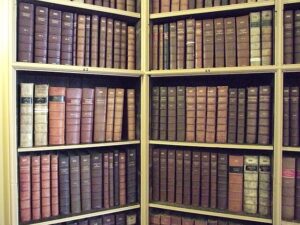
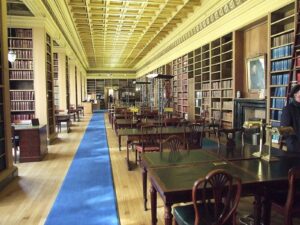
Such success comes at a cost. Books and manuscripts need to be shelved and conserved when necessary. Staff are needed to invigilate, give access, produce books and documents for readers, and guard against theft. There is a need for skilled administrators to run the institutions and learned librarians to curate the collections. The Advocates took this seriously, trying in 1820 to recruit G. F. Benecke from Göttingen to run the Library on the principles of modern librarianship. But it became progressively clear in the nineteenth century that a relatively small bar was struggling to maintain a huge general, effectively national, library. In 1925, with the generosity of Sir Alexander Grant of Forres and matching government support, the National Library of Scotland was founded to which the Faculty of Advocates donated its non-legal collections.
Other bodies, such as the Society Writers to H.M. Signet, the Society of Solicitors to the Supreme Court, the Royal Faculty of Procurators in Glasgow, and the Society of Advocates in Aberdeen, also collected significant libraries. Smaller local groups also collected libraries, as John Finlay has discussed and shown. Other bands of lawyers, who incorporated either specially by a Royal Charter or under an Act of Parliament of 1865 as Faculties of Procurators, also developed collections of books. Your blogger has seen in a collection in the U.S.A. a vellum-bound continental civil-law text with an ex libris inscription from the library of such a local Faculty. Some bodies also built spectacular rooms and buildings for their collections, demonstrating their taste and prosperity, sometimes attached to court buildings, such as the libraries of the Society of Solicitors to the Supreme Courts or Writers to the Signet, or separate but convenient for members, such as that of the Royal Faculty of Procurators in Glasgow or of the Society of Advocates in Aberdeen.
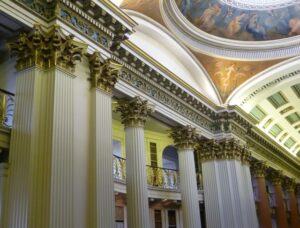
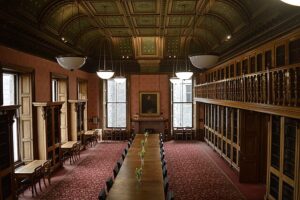
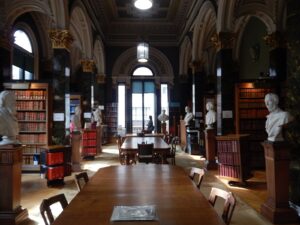
All these bodies have felt the same significant financial pressures, if much less extreme, that led the Faculty of Advocates to give its non-legal collection to the nation. This has led to sales after the Second World War. The legal world had changed: the establishment of the Law Society of Scotland in 1948 threatened the local societies. Their investments were badly affected by the two World Wars and the inflation of the 1970s. For example, the Signet Library had a series of significant sales from its collections between 1959 and 1976, though it still retains very important legal and non-legal collections. There is a thoughtful and important account by James Hamilton available on YouTube. In 1968 there was an auction of the non-legal books of the Royal Faculty of Procurators in Glasgow. Later, the Royal Faculty’s rich collection of historical Civil-Law (and some French) legal literature was acquired by the Robbins Collection at the University of California at Berkeley. There is a list on the webpages. In 1976 Sotheby’s auctioned a large part of the collections of the Society of Advocates in Aberdeen. It was meant to be an auction just of the non-legal books, but in fact many legal books were also taken and sold, such as the Society’s set of Session Papers, acquired in 1835 from the Library of Andrew Skene. The story can be found in the history of the Society written by the late Dorothea Bruce. The Session Papers are now in the U.S.A.
Books continue to circulate. David Murray was a prominent lawyer and important cultural figure in the recent history of Glasgow and its University, which contains important Murray Collections of books and manuscripts. In 1902, he donated a small set of volumes of material on legal reform and international law to the library of the Royal Faculty of Procurators, which has recently been offered for sale by an antiquarian book dealer in the U.S.A. in a Catalogue of association copies.
Of course, it is not only professional institutions that have sold their collections in part or entire. Noblemen in the past assembled libraries just as they collected cabinets of curiosities to demonstrate their learning, both of which they could use as instruments to extend their patronage. The international links by which such collections were put together tell us about politics as well as patronage. The auctioning of such libraries (heirs did not always value them except as financial assets) could cause great excitement in the seventeenth, eighteenth and nineteenth centuries as well as today. Such collections tell us much about changing general taste in book-collecting as well as individual interests. The important study by K. G. Baston explores the collection made by one Scots lawyer and its history. One can note the sale (and dispersal) of the library of the Earls of Minto (your blogger owns two volumes of MSS from it) and of the family of Fletcher of Saltoun, just to mention two collections of importance for eighteenth-century Scots law and Scottish legal history.
Books have always circulated. Virtually from the beginning of movable-type printing, there were individuals who valued books not for their contents but as objects, seeking fine items produced by notable printing houses. Books are important culturally as collections, not just as individual items. In individual books paratextual material and provenance can be of vital significance; sometimes the context is necessary to make this meaningful.
But modern professional societies understandably do not see themselves as guardians of culture in the manner of the eighteenth century. This is now the role of national libraries, national archives, and the libraries of major research universities, and if there are some major independent research libraries such as, notably, the Huntingdon in California or the Folger in Washington D.C., and indeed more minor ones, these are not the libraries of professional bodies. But, of course, consciously “national” collecting always requires choice, affected by current ideologies and politics. This is in itself an interesting if different issue.
(All images from Wikimedia Commons)

